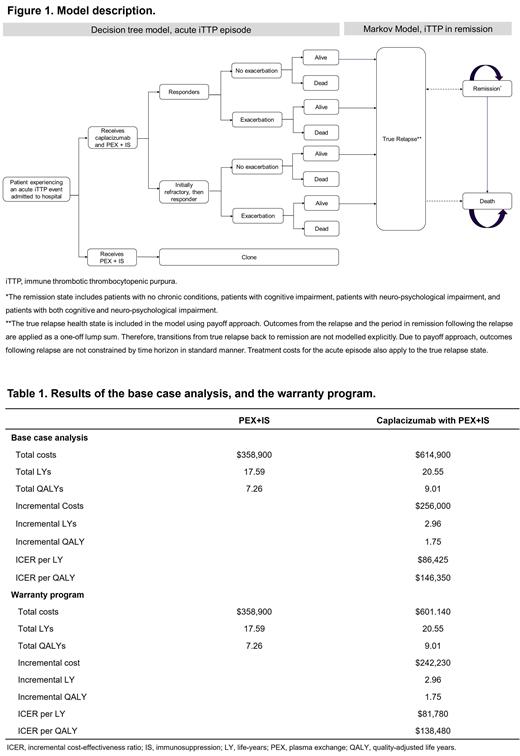Background
Immune thrombotic thrombocytopenic purpura (iTTP) is a rare, life-threatening thrombotic microangiopathy. Caplacizumab is a humanized nanobody that inhibits formation of microthrombi in iTTP by disrupting binding of von Willebrand factor to platelets. It is the only treatment approved in combination with plasma exchange therapy (PEX) and immunosuppression (IS) for the treatment of iTTP. The United Kingdom National Institute for Health and Care Excellence (NICE) committee reviewed cost-effectiveness of caplacizumab. The committee concluded that addition of caplacizumab to PEX+IS is cost-effective and recommended that the drug be reimbursed in the UK. The Sanofi Promise Warranty Program ® (SPWP) was introduced in January 2023 in the US. It refunds the full cost of caplacizumab to the hospital when treatment is discontinued due to non-response defined as refractoriness (patient with platelet counts <50 × 10 9/L after 4 days of combined treatment with caplacizumab and PEX+IS; up to 6 doses are refunded), or exacerbation (new drop in platelet count after initial platelet count normalization [>150 × 10 9/L], necessitating re-initiation of PEX after ruling out any causes for the drop in platelet count other than iTTP pathophysiology, up to 12 pre-exacerbation doses are refunded).
Objectives
To evaluate the cost-effectiveness of adding caplacizumab to PEX+IS from a US perspective within the context of SPWP.
Methods
The NICE model was adapted to the US setting by replacing UK costs with US costs and discount rates. All clinical assumptions and structure remain unchanged. Clinical inputs were derived from the HERCULES trial (NCT02553317) intent-to-treat population (mean age: 46 years; females: 69%, exacerbation rates: 4.17% during double blind phase and 12.50% in total; refractoriness: 0%). The model consisted of a 3-month decision tree, which captured patient treatment and outcomes over the acute iTTP episode, followed by a long-term Markov model (time horizon: up to 55 years; 3-monthly cycles; Figure 1). An annual discount rate of 3% was applied for both costs and quality-adjusted life-years (QALYs).
Under the SPWP, the cost of caplacizumab was assumed to be $0 for refractory patients and those who exacerbate early, no discount was applied for patients who experience exacerbations after drug discontinuation, however, clinical outcomes were captured.
Results
Prior to the SPWP, caplacizumab addition to PEX+IS delivered a gain of 1.75 QALYs (2.96 life-years [LYs]) as compared with PEX+IS alone, at an increased lifetime cost of $256,000. The incremental cost effectiveness ratio (ICER) was $146,350 per QALY and $86,420 per LY gained ( Table 1).
An estimated 4.17% of treated patients qualified for the SPWP. With this outcomes-based program, the ICER improved to $138,480 per QALY and $81,780 per LY gained, respectively ( Table 1).
Conclusion
Based on these analyses using the UK NICE model adapted with US costs, caplacizumab is cost-effective considering WTP threshold of $150,000 to $200,000 and has improved cost-effectiveness when the warranty program is taken into account. Outcomes based programs can improve the cost effectiveness of a treatment in addition to mitigating concerns of perceived uncertainty of efficacy in treating patients with iTTP in the US.
Disclosures
Sullivan:Sanofi: Consultancy. Chaturvedi:Sanofi: Other: Advisory board participation; Sobi: Honoraria; Takeda: Other: Advisory board participation; Sanofi Genzyme: Consultancy; Alexion: Consultancy, Other: Advisory board participation. Gautam:Sanofi: Current Employment. Arnaud:Sanofi: Current Employment.


This feature is available to Subscribers Only
Sign In or Create an Account Close Modal